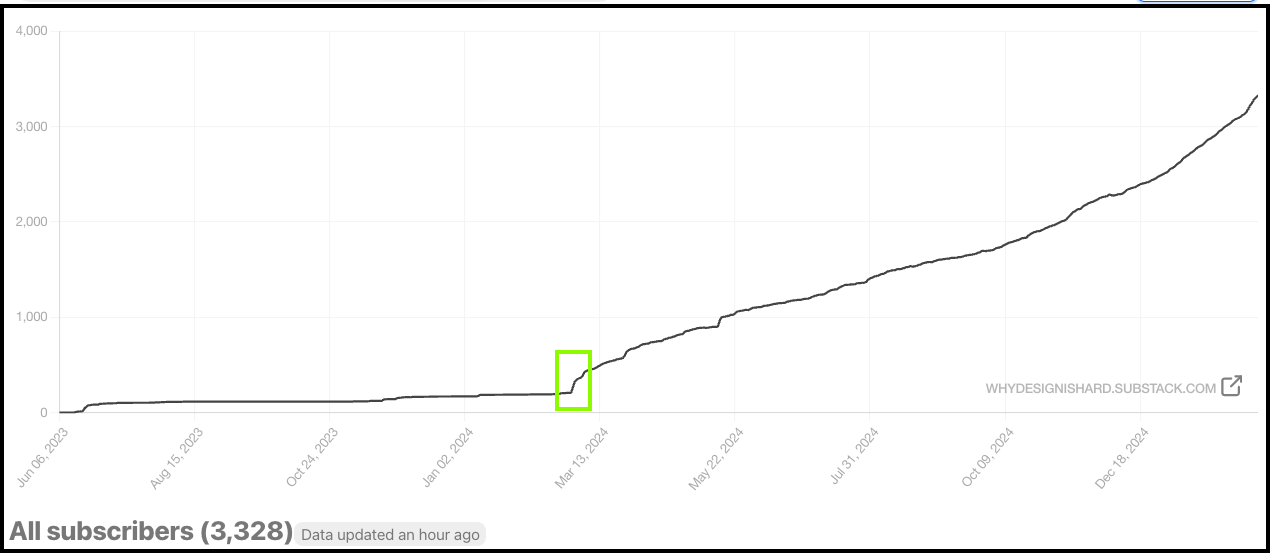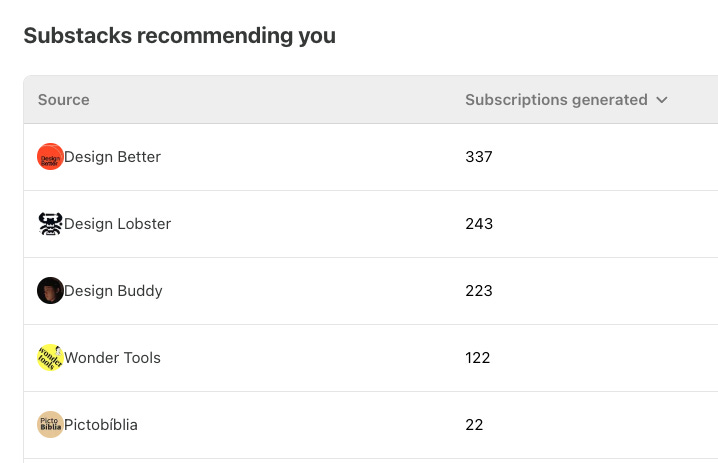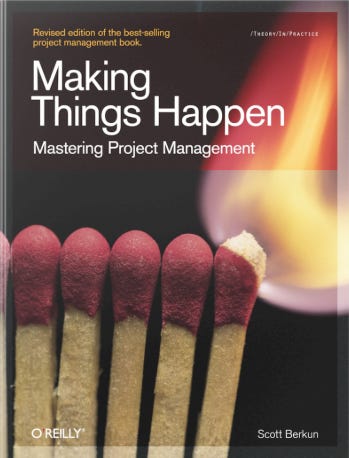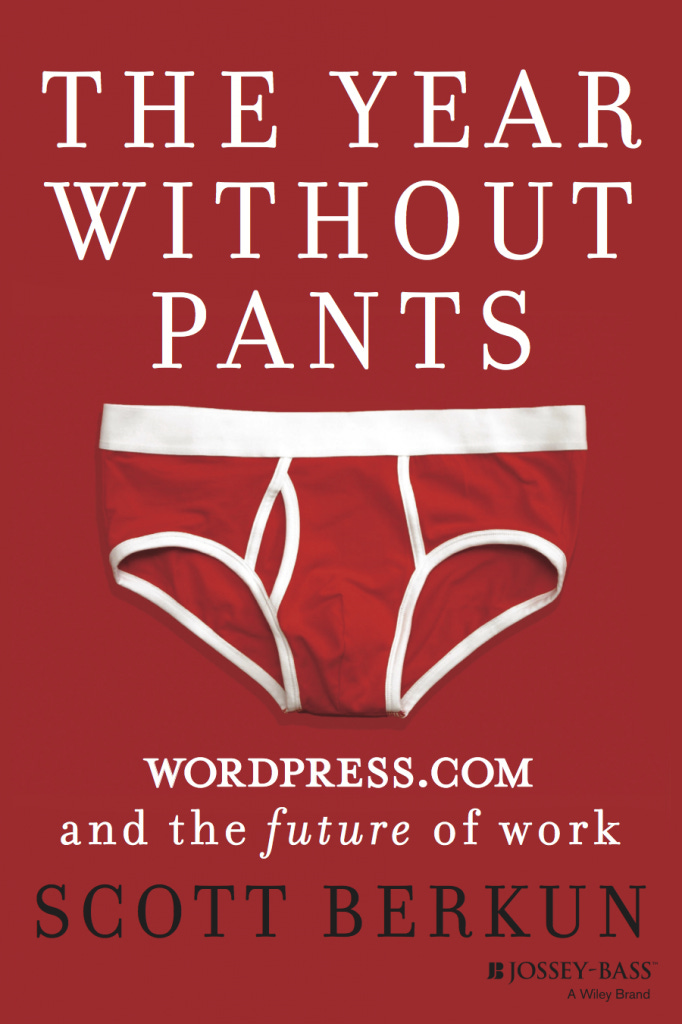Lessons from writing this Substack
What I've learned, top posts, stats and more
I published the first post on this Substack on June 5th, 2023, officially announcing this project. The book launched in Sept. 2024 and I’ve been posting at least weekly for months. There are now almost 100 posts and it’s time for a summary.
First of all: thanks for being here and helping this book along. I’m grateful to everyone who has read, liked, shared and commented here. It’s fuel for writers like me and it’s always appreciated. It takes hours to write these posts, even though it just takes seconds to swipe away to something else.
To share what I’ve learned so far, in this post I will:
Review major stats
Share the most popular posts
Review the office hours experiment
Explain where these ideas came from
What’s next here?
Stats: Steady growth to 3,000+ subscribers
This has been a strange project in part because it is my first book since 2020, the longest time between books in my career (It was a challenging few years). This project did not have a marketing plan, and since writing is a strong suit for me this Substack has been the primary way to promote the project.
The first big spike in subscribers came when I reposted my Feb 27th, 2024 post Design Talent is Distraction to LinkedIn. It got picked up by some other well known UX folks, including Peter Merholz who has a large following there, and the trajectory changed (see chart below). I posted weekly before and after, but this shift made me pay more attention to LinkedIn, where my own following has grown since. I had about 4,000 followers before all this, and now it’s closer to 7,000.
I will continue posting regularly on LinkedIn, mostly with new material. Follow me there if you want to here from me every day (or join my primary list for big announcements only). I’ve missed Twitter and LinkedIn is the best approximation of that interactivity I’ve found.
Many of you have shared posts and recommended this list. Thank you! From the data Substack gives me, it seems the biggest boost to new subscribers is other Substacks. Almost 1/3rd of all subscriptions here came from these recommendations and I’m grateful to them.
Most popular posts
Everyone tries to game social media with their titles. As a writer I always hope the titles that get the most attention align with the core ideas of the book and that’s true here. Yay!
While none of these are viral sensations (there’s still time - hit that share button!), this project is for a specialized audience compared to most of my books. If these ideas reach the right 5,000 people it is a success and it’s well on its way.
Design Talent Is a Distraction (7.5k views)
Bad Design Makes Money (5k views)
What Do Designers Really Need To Know (5k views)
7 Best Books For Designers In The Real World (4k views)
Why Designers Fight With Each Other (2.9k views)
Review of the Office Hours Experiment
Before the book launch I held office hours Thursday mornings at 9am PST on Zoom. I’m good at live Q&A and this was a way another attempt to get attention for the book.
In short: it was fun! I’d do this again. 5 to 7 people usually attended, just the right amount for a lively conversation. I doubt it helped sales but it was a perk to you for being on this list.
If you missed it: here’s my video recap from the Sept, 30th, 2024 session, with a focus on knowing your superpowers as a designer and BS about productivity:
The origin of these ideas
I started publishing on these topics over twenty years ago, while I worked at Microsoft as the UX Training Manager for the company (1999-2001). My opinions as a teacher came from my experiences doing the work.
From 1994-1995 I did most kinds of user research: lab studies, cognitive walkthroughs, surveys, usability benchmarks, interviews, affinity diagrams and on it went. And then from 1995-to-1999 I switched to a project leadership role for parts of Internet Explorer 3.0-5.0, one of the earliest web browsers.
In that role I had to do everything: lead cross-discipline teams, make interaction design wireframes, write specs, meet with executives, triage bugs, make prototypes, make deals with partner companies, help with W3C standards, lead team meetings, and on it went. It was an amazing experience. Millions of people used the things my teams built. I wrote about what I learned in the bestselling book Making Things Happen.
Then in 2010-2012 I joined the startup Automattic, Inc. as one of the first team leads. At first my team did not have a designer or researcher, so I played these roles. I wrote about what I learned from this experience in the Amazon book of the year, The Year Without Pants, which documents exactly how I worked and led the team, including screenshots of works in progress before they launched. The book cover for it is… well, something. How many chances in life do you get to put more images of ridiculous looking underwear out into the world? I took this one.
These uncommon experiences both in and out of UX roles shaped how I look at the field today. You can read the best of my 20 years of design writing here. In short, as a team leader I was taught a pragmatism that the UX professions still need to learn.
For fun, here’s an observation that might sound familiar if you’ve read Why Design Is Hard. The surprise is it’s from a November 2001 essay:
Unless you have the power to make business and development decisions for your project, some of your energy will be spent influencing those that do. Talented usability engineers or interaction designers may have limited skill in influence, despite how this can constrain their ability to influence design decisions.
At this rate in 2050 I’ll still be writing about the same things. Who knows! Lets hope I’m still around and writing about something, whatever it is.
What’s next? It’s up to you
The book has been out for 5 months. Typically I’d move on to the next project by now. I’ve already started on the next book, about Rules to Live By, but I’m currently splitting my time.
I’ve kept going here for four reasons:
I have deep love for designers and want you to improve the world!
This list has grown steadily and my posts get attention (thanks!)
I have a big list of topics I haven’t written about here yet
I’d like to do more live speaking about these ideas
To help me keep going you can: read, like, share and of course, buy the book! Or tell me a topic or question you’d like me to answer. I love taking requests. Thanks.






